Sisters of Mercy leave legacy of Catholic education, healthcare and social services across our region
 The Sisters of Mercy are pictured with Maria Morrow, the first resident of Holy Angels in Belmont. (Photos provided by Sisters of Mercy of the Americas, Mercy Heritage Center, Belmont, N.C.)When three Sisters of Our Lady of Mercy arrived in Wilmington to found a new community, they were stepping into unchartered territory for their order.
The Sisters of Mercy are pictured with Maria Morrow, the first resident of Holy Angels in Belmont. (Photos provided by Sisters of Mercy of the Americas, Mercy Heritage Center, Belmont, N.C.)When three Sisters of Our Lady of Mercy arrived in Wilmington to found a new community, they were stepping into unchartered territory for their order.
It was 1869 – the post-Civil War South. Ulysses S. Grant had just become president, and the United States was on the brink of unprecedented industrialization and ingenuity. The “golden spike” had been driven to finish off the Transcontinental Railroad, and women’s suffrage advocates Susan B. Anthony and Elizabeth Cady
Stanton were joining forces to campaign for the vote. But North Carolina, readmitted to the Union only a year earlier, remained under Reconstruction. There were about a thousand Catholics, most of whom lived in the eastern part of the state.
Over the next 153 years, this group of determined religious women lived the charism of service instilled by their Irish founder, Mother Catherine McAuley – blazing a path in education, healthcare and social service ministries that helped transform the Tar Heel State.
BELMONT SISTERS THEN AND NOW
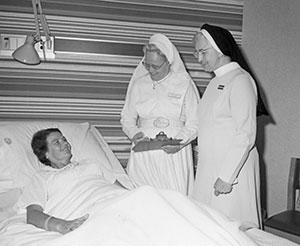 The Sisters of Mercy opened St. Joseph Sanitorium for tuberculosis patients in Asheville in 1900. It became a general hospital in 1938.Known today as the Sisters of Mercy, the 32 women living at Sacred Heart Convent in Belmont are counted among 2,142 members of the Institute of the Sisters of Mercy of the Americas. They live within sight of Belmont Abbey and Belmont Abbey College, where their history in the Diocese of Charlotte began.
The Sisters of Mercy opened St. Joseph Sanitorium for tuberculosis patients in Asheville in 1900. It became a general hospital in 1938.Known today as the Sisters of Mercy, the 32 women living at Sacred Heart Convent in Belmont are counted among 2,142 members of the Institute of the Sisters of Mercy of the Americas. They live within sight of Belmont Abbey and Belmont Abbey College, where their history in the Diocese of Charlotte began.
In the years following their arrival in Wilmington, some of the sisters moved inland to Hickory, Asheville, Salisbury and Charlotte to set up schools – desperately needed to heal the socioeconomic wounds of the Civil War and impart the faith to Catholic families in largely Protestant areas. In 1892 they established a convent in Belmont at the request of Benedictine Abbot Leo Haid of Belmont Abbey. They founded Sacred Heart Academy (later College), a boarding and day school for girls adjacent to the abbey. They also staffed nearby St. Benedict School, educating black children who, under North Carolina law, were not allowed to attend school alongside white children.
In the ensuing years they courageously resisted racial segregation and worked tirelessly to provide equal education, healthcare and other assistance for the poor, the sick, and other vulnerable populations – establishing at least seven schools, an orphanage, a nursing school in Charlotte, and three hospitals (including what’s now Atrium Health Mercy in Charlotte and Mission Hospital in Asheville).
“We say that we stand on the shoulders of great women,” says Mercy Sister Lillian Jordan. Professed for 58 years, she served primarily in education – first as a teacher and then as a principal in North Carolina, West Virginia and Kentucky. She is now the administrator of the Sacred Heart Retirement Center in Belmont.
Sister Lillian grew up in a military family, traveling throughout the U.S. and Europe. She was taught in high school by the Daughters of Charity, who encouraged her to go to Sacred Heart College. There she encountered the Sisters of Mercy, and her desire was sparked for a religious vocation of service.
 After high school she took a teaching position at St. Ann School in Charlotte, and four years later in 1964, she entered the Sisters of Mercy.
After high school she took a teaching position at St. Ann School in Charlotte, and four years later in 1964, she entered the Sisters of Mercy.
“My call, I had a sense, was to be in North Carolina where Catholicism was little known and there was a great need to witness to the Church,” she says.
Sister Lillian emulated those first Sisters of Mercy who established one of the state’s first integrated schools, Academy of the Incarnation in Wilmington, by devoting 54 years of her career to education – 40 as a principal.
Working alongside her, serving the daily community and prayer life of the sisters, is Mercy Sister Carolyn McWatters.
A professed Sister of Mercy for 51 years, Sister Carolyn is no stranger to North Carolina. She taught 25 years at schools and parishes in Wilmington and in Charlotte.
She attributes her vocation to a love of reading fostered by her teacher – a Sister of Mercy, who made a lasting impression on her when she was 12.
“I remember distinctly in fifth or sixth grade, I was an avid reader of Nancy Drew books. Sister said to try reading the life of a saint, so I tried the Vision Books. That got me hooked!” Sister Carolyn recalls. “I think that’s when I decided that maybe that was where God was calling me; that I was supposed to be a saint, too, and that the way I would do that would be in religious life.”
She believes her return to the diocese last summer, after serving for years in St. Louis, was led by the Holy Spirit. “After 25 years, I am home,” she says.
LOVE OF SERVICE
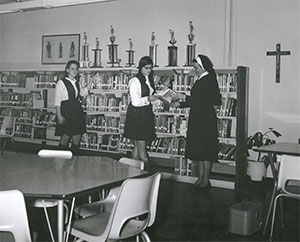 Mercy Sister Mary Andrew Ray taught at Our Lady of the Assumption School in Charlotte.
Mercy Sister Mary Andrew Ray taught at Our Lady of the Assumption School in Charlotte.  The Sisters of Mercy opened Sacred Heart Junior College in Belmont in 1935. Classes such as anatomy were taught by the Sisters of Mercy. The Mercy sisters’ commitment to service also attracted Mercy Sister Mary Andrew Ray.
The Sisters of Mercy opened Sacred Heart Junior College in Belmont in 1935. Classes such as anatomy were taught by the Sisters of Mercy. The Mercy sisters’ commitment to service also attracted Mercy Sister Mary Andrew Ray.
Sister Mary Andrew’s family was one of the founding families of St. Patrick Church (now Cathedral), her cousin was a Sister of Mercy, and the sisters were her teachers throughout her 12 years of Catholic schooling. There she saw first-hand the sisters’ love and care for others.
“I volunteered at the cathedral, cleaning the marble, and helped around the school. I was around them a lot,” she recalls.
College did not interest her after high school, but she knew she wanted to help people. After receiving plenty of hints about joining the Sisters of Mercy, one day a sister did something that sealed the deal for her.
“I worked at the Sign of the Cross Catholic Information Center in high school. It was a bookstore, and a priest was also there to answer people’s questions. When
Sister Cecilia was getting ready to go to school up north, she came by the store and left a note for me. It said, ‘What are you waiting for? The Holy Ghost isn’t going to knock you down and drag you to the convent!’ It wasn’t long after that, that I entered. I have laughed at that a lot,” she says.
When she entered the Sisters of Mercy in 1952, she told the mother superior she wasn’t sure how she could serve the community.
“I told her, ‘I don’t want to nurse or teach,’ which was all we did in those days,” Sister Mary Andrew explains. “Mother Maura said, ‘There is always secretarial work.’
She said, ‘You can just give it a try. That is what the novitiate is for.’”
 Mercy Sister Eugenia Hartman is pictured with her students at St. Benedict School at Belmont Abbey. Sister Mary Andrew went on to teach for 15 years, at St. Michael’s School in Gastonia, the former Sacred Heart School on the Sacred Heart Campus in Belmont,
Mercy Sister Eugenia Hartman is pictured with her students at St. Benedict School at Belmont Abbey. Sister Mary Andrew went on to teach for 15 years, at St. Michael’s School in Gastonia, the former Sacred Heart School on the Sacred Heart Campus in Belmont,
St. Mary’s School in Wilmington, and Our Lady of the Assumption School in Charlotte.
She also served in several leadership positions with the community before returning to college to earn a degree in teaching English as a Second Language after the sisters decided to open their own ESL program on the Sacred Heart Campus.
Teaching is fundamental for the Sisters of Mercy, she explains. “We know that as education is more than just going to classes, it is the whole environment and the living of our vows, just knowing that we are here to serve.”
After seven decades, Sister Mary Andrew is still serving the community – now as one of its historians.
“I have loved everything,” she says. “I have sometimes thought, ‘I don’t know if I can do this.’ But God says, ‘Oh yes, you can.’ He hasn’t taken no for an answer easily!”
“Here I am 70 years later,” she says, smiling.
Sister Mary Andrew isn’t the only local vocation inspired by the Sisters of Mercy over the past century. Dozens of women have been inspired to join the order, and each sister has had an impact on the Church in western North Carolina.
Among them is Mercy Sister Mary Robert Williams. Professed for 72 years, her family is part of the Church’s foundation here: 13 of her relatives are buried at Old
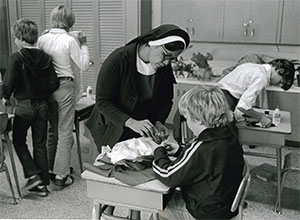 St. Joseph Church in Mount Holly, the oldest Catholic church in western North Carolina. She grew up going to picnics at the old church every Labor Day, when the family would get together to clean up the cemetery.
St. Joseph Church in Mount Holly, the oldest Catholic church in western North Carolina. She grew up going to picnics at the old church every Labor Day, when the family would get together to clean up the cemetery.
Her aunt joined the Sisters of Mercy in 1921 and moved in to the sisters’ convent located behind St. Peter Church in Charlotte. “The sisters were part of our life,” she says. “They were in and out of our house all the time.”
Her family helped the Sisters of Mercy with their everyday needs, and her father helped drive the sisters to teach religious education classes at St. James Church in Concord every Sunday.
“The sisters didn’t drive, so my mother and father would take them grocery shopping,” she recalls. “My mother was always concerned they wouldn’t have enough money for food. They had maybe $20 to buy food for eight sisters. We didn’t have extra money, but she would take some just in case they needed money for food.”
“I grew up with the Sisters of Mercy, but I never thought I’d be one,” she says. “I thought I’d be a nurse. Here I am, 72 years later.”
She entered the novitiate with nine other young women in 1950.
First she taught kindergarten for five years at St. Michael School in Gastonia, and then first grade for 18 years, and then served as principal for 13 years at Our Lady of the Assumption School.
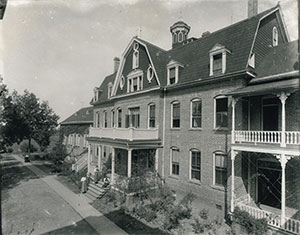
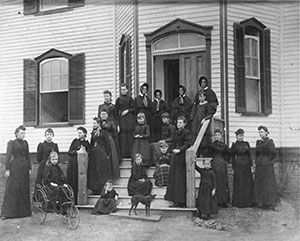 The Sisters of Mercy opened Sacred Heart Academy in Belmont in 1892. She had a change of pace when Father Richard Allen invited her to Salisbury to serve as a pastoral associate at Sacred Heart Church – an assignment that lasted for 31 years until her retirement in 2014 at 81.
The Sisters of Mercy opened Sacred Heart Academy in Belmont in 1892. She had a change of pace when Father Richard Allen invited her to Salisbury to serve as a pastoral associate at Sacred Heart Church – an assignment that lasted for 31 years until her retirement in 2014 at 81.
Just like those pioneering Sisters of Mercy before her, Sister Mary Robert loves helping people in need. She was instrumental in starting Rowan Helping Ministries’ homeless shelter. She also worked with the battered women’s shelter and Operation Suitcase, which provides supplies for children in foster care. An outreach program based out of Sacred Heart Church in Salisbury was named for her in gratitude for her years of service there.
Reflecting on her life with the Mercy sisters, she shares, “It’s been a real family, a real community and a union of charity as Mother McAuley would say. They are a great bunch of women.”
LOVE OF GOD AND NEIGHBOR
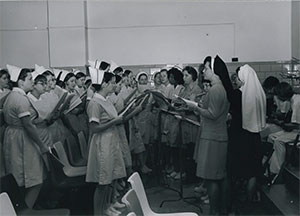
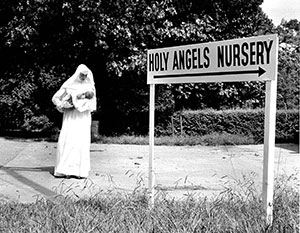 Teaching black and white children in the segregated South. Caring for tuberculosis and AIDS patients. Educating nurses and staffing hospitals for both black and white people in growing population areas. Providing medical care to the poor and uninsured. Developing affordable housing. Providing a welcoming home for orphans, medically fragile children and adults, domestic violence victims, the homeless, and new moms in need. Providing jobs and life skills training for adults with intellectual disabilities. These are just some of the works of mercy the Sisters of Mercy are known for.
Teaching black and white children in the segregated South. Caring for tuberculosis and AIDS patients. Educating nurses and staffing hospitals for both black and white people in growing population areas. Providing medical care to the poor and uninsured. Developing affordable housing. Providing a welcoming home for orphans, medically fragile children and adults, domestic violence victims, the homeless, and new moms in need. Providing jobs and life skills training for adults with intellectual disabilities. These are just some of the works of mercy the Sisters of Mercy are known for.
These are just some of the works of mercy the Sisters of Mercy are known for.
Today, though they no longer run hospitals and schools as they once did, the Sisters of Mercy continue to support education, healthcare and social services throughout our region thanks to the Sisters of Mercy of North Carolina Foundation, which has given out over $97 million in grants to local organizations since 1996.
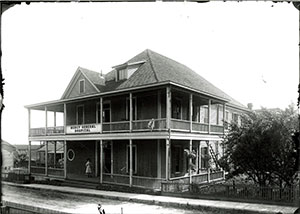 Anyone who surveys the landscape of all that the Sisters of Mercy have accomplished across western North Carolina over the past century and a half understands that their motivation comes from a deep love of God and love of neighbor.
Anyone who surveys the landscape of all that the Sisters of Mercy have accomplished across western North Carolina over the past century and a half understands that their motivation comes from a deep love of God and love of neighbor.
“There’s a real sense that it is all God’s work,” says Sister Carolyn. “Nobody could foresee what has happened would have happened, and perhaps that it would have even been possible. But that is a good indication that what happens is all God’s will.”
Every time she thinks about the work the Sisters of Mercy have been accomplished over the decades, “it makes me very proud,” she says. “We believe wherever there is one Sister of Mercy, we are all there.”
Sister Lillian agrees. “I can’t imagine that they (the earlier Sisters of Mercy) would think anything other than gratitude for the beginnings that they provided for us and what they see happening.”
Adds Sister Mary Andrew, “My father used to say sometimes that, ‘You have this today because of what the sisters sacrificed. When I was in school sometimes the sisters didn’t even have sheets to put on their beds.’ He would always remind me of this.
“We do have to keep remembering these things and know that we stand on the shoulders of great women.”
— SueAnn Howell and Patricia L. Guilfoyle, Catholic News Herald
Who are the Sisters of Mercy?
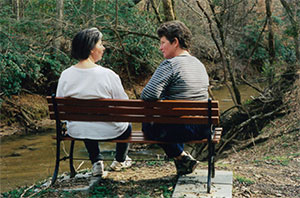 Two Sisters of Mercy spend some time outdoors at the Well of Mercy Retreat Center in Hamptonville. The Sisters of Mercy is an international community of Roman Catholic women who dedicate their lives to God through vows of poverty, chastity, obedience and service. They live a life of prayer and service, responding to the needs of people facing poverty, illness and a lack of education. They sponsor and serve in more than 160 service organizations – such as schools and hospitals – that address those needs. The community was founded in 1831 by Mother Catherine McAuley in Dublin, Ireland.
Two Sisters of Mercy spend some time outdoors at the Well of Mercy Retreat Center in Hamptonville. The Sisters of Mercy is an international community of Roman Catholic women who dedicate their lives to God through vows of poverty, chastity, obedience and service. They live a life of prayer and service, responding to the needs of people facing poverty, illness and a lack of education. They sponsor and serve in more than 160 service organizations – such as schools and hospitals – that address those needs. The community was founded in 1831 by Mother Catherine McAuley in Dublin, Ireland.
Today more than 6,000 Sisters of Mercy serve in more than 30 countries. Find out more about them online at www.mercyworld.org and www.sistersofmercy.org.
Enduring impact
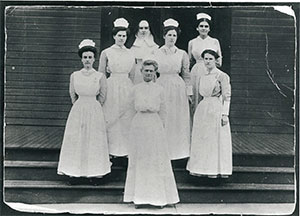 The Sisters of Mercy have helped build up the Church in North Carolina through corporal and spiritual acts dating back more than 150 years, providing comfort and sharing God’s love with the most vulnerable among us. Among their good works:
The Sisters of Mercy have helped build up the Church in North Carolina through corporal and spiritual acts dating back more than 150 years, providing comfort and sharing God’s love with the most vulnerable among us. Among their good works:
- Teaching black and white children in the segregated South
- Caring for those afflicted with tuberculosis and AIDS
- Educating nurses and staffing hospitals for both black and white people in growing areas of the state
- Providing medical care to the poor and uninsured
- Developing affordable housing
- Providing a welcoming home for orphans, medically fragile children and adults, domestic violence victims, the homeless, and new moms in need
- Providing jobs and life skills training for adults with intellectual disabilities
Key dates for the Sisters of Mercy in North Carolina:
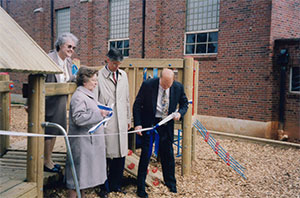 Sisters of Mercy celebrate the opening of a new playground at Catherine’s House in Belmont in 1999.1869 Sisters of Our Lady of Mercy establish a convent in Wilmington at the request of Bishop (later Cardinal) James Gibbons. Three sisters open Academy of the Incarnation there.
Sisters of Mercy celebrate the opening of a new playground at Catherine’s House in Belmont in 1999.1869 Sisters of Our Lady of Mercy establish a convent in Wilmington at the request of Bishop (later Cardinal) James Gibbons. Three sisters open Academy of the Incarnation there.
1880 Sisters open Mt. St. Joseph Academy in Hickory, which they sell in 1888.
1887 They open O’Donoghue School, forerunner of today’s St. Patrick School in Charlotte.
1892 Benedictine Abbot Leo Haid of Belmont Abbey requests the sisters’ presence in Belmont. The sisters establish a boarding and day school called Sacred Heart Academy.
1900 Sisters open St. Joseph’s Sanitorium in Asheville for tuberculosis patients.
1906 Mercy Hospital opens in Charlotte.
1910 Sisters open St. Leo’s Junior Military School for Boys, which operates until 1962.
1913 Sisters in North Carolina join the Sisters of Mercy, founded in Dublin, Ireland, in 1831.
1935 Sacred Heart Junior College in Belmont is founded.
1938 St. Joseph’s Sanitorium in Asheville becomes a general hospital.
1946 Three Sisters of Mercy leave Belmont for Guam, where they receive 10 women in the first year.
1955 Sisters begin staffing Charlotte Catholic High School.
1956 A young mother asks for the sisters’ help caring for her seriously ill infant daughter. Other parents of children with disabilities ask for help. In response, the sisters open a home for the children that later becomes Holy Angels in Belmont.
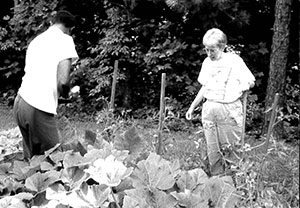 1957 Sisters establish Sacred Heart Grade School in Belmont, which runs until 1988.
1957 Sisters establish Sacred Heart Grade School in Belmont, which runs until 1988.
1966 Sacred Heart College becomes a senior college. It closes in 1987.
1991 House of Mercy,
a home for those living with advanced AIDS, opens in Belmont.
1992 Catherine’s House, a transitional facility for women and women with children who are homeless, opens in Belmont.
1995 Mercy Hospital, known as Mercy Health Services, is sold.
1996 Sisters of Mercy of North Carolina Foundation is established with proceeds from the sale of Mercy Health Services. As of this year, the foundation has awarded more than $97 million in grants supporting the work of selected tax-exempt healthcare, educational and social service organizations.
1997 Sisters of Mercy of North Carolina join with Sisters of Mercy in Baltimore to form Mercy Housing Southeast that has developed 2,500 affordable homes for low-income people.
Well of Mercy Retreat Center opens in Hamptonville.
1998 Sisters of Mercy sell St. Joseph Hospital to Memorial Mission Medical Center. Sisters retain ownership of Sisters of Mercy Services Corp., which oversees the operations of Sisters of Mercy Urgent Care Inc.; Mountain Health Services Inc.; Mountain Health Contracting Services Inc.; and Catherine McAuley MERCY Foundation Inc.
 2008 The Sisters of Mercy, Regional Community of North Carolina, joins with the regional communities of Baltimore, Cincinnati and St. Louis to form the Sisters of Mercy – South Central Community.
2008 The Sisters of Mercy, Regional Community of North Carolina, joins with the regional communities of Baltimore, Cincinnati and St. Louis to form the Sisters of Mercy – South Central Community.
2021 The Sisters of Mercy – South Central Community based in Belmont becomes the Institute of the Sisters of Mercy of the Americas, comprised of 2,142 sisters
from North and South America, Central America, Asia and the Pacific.


